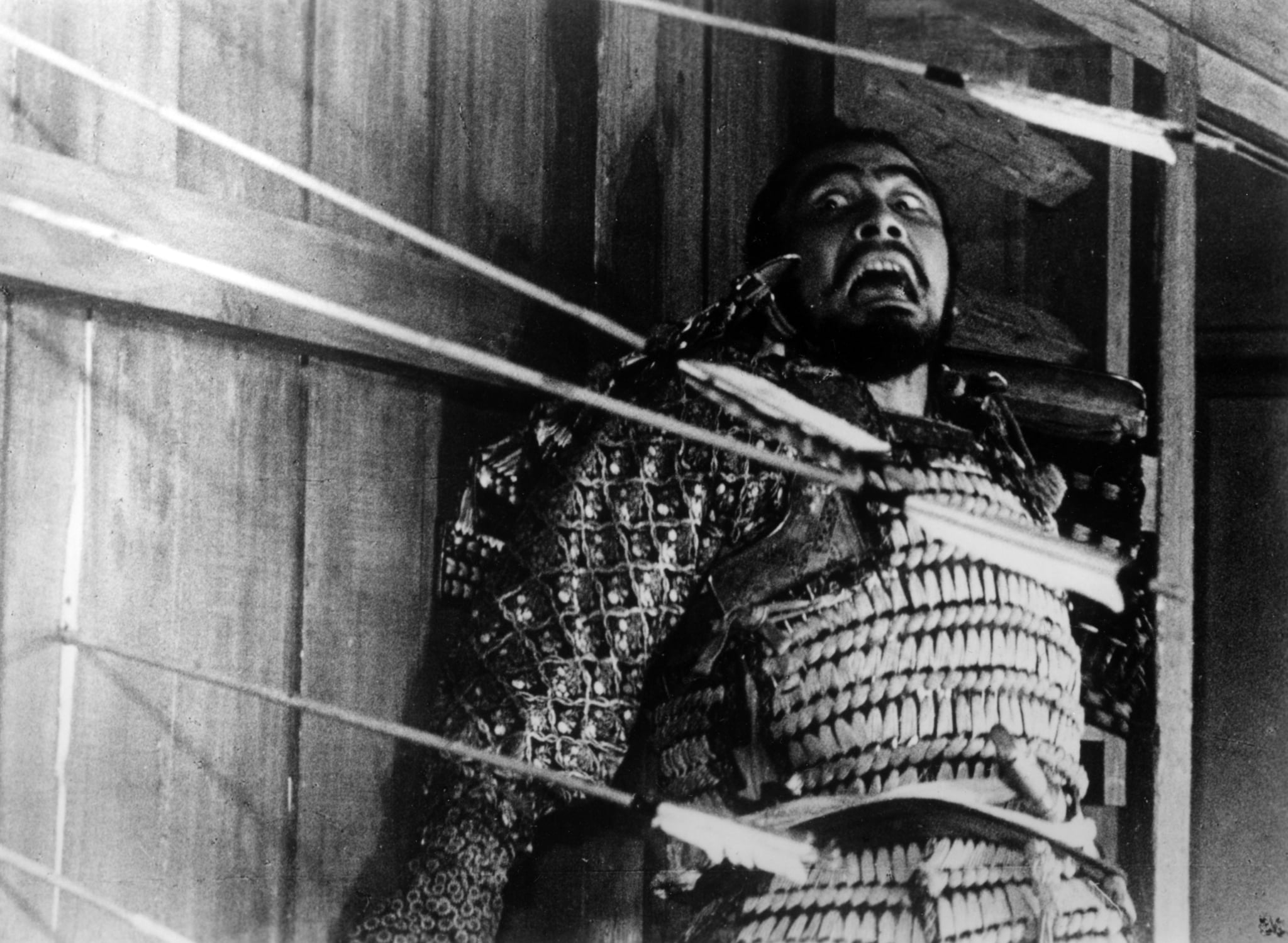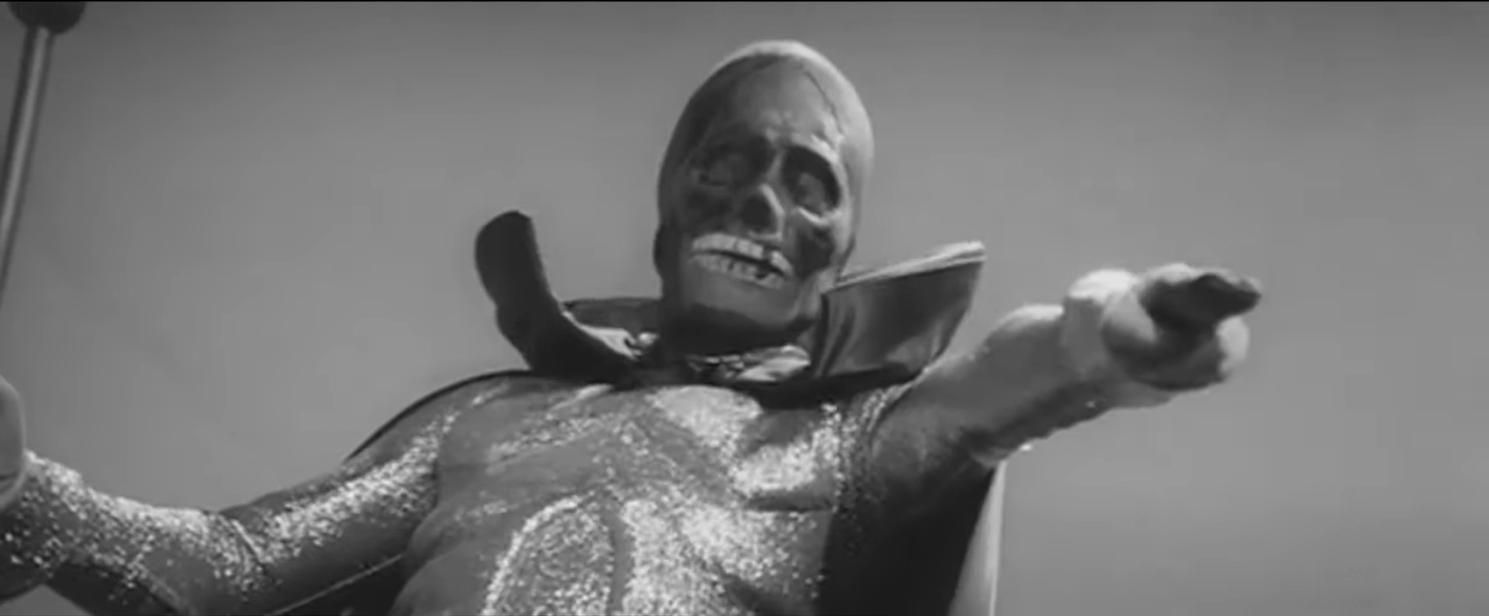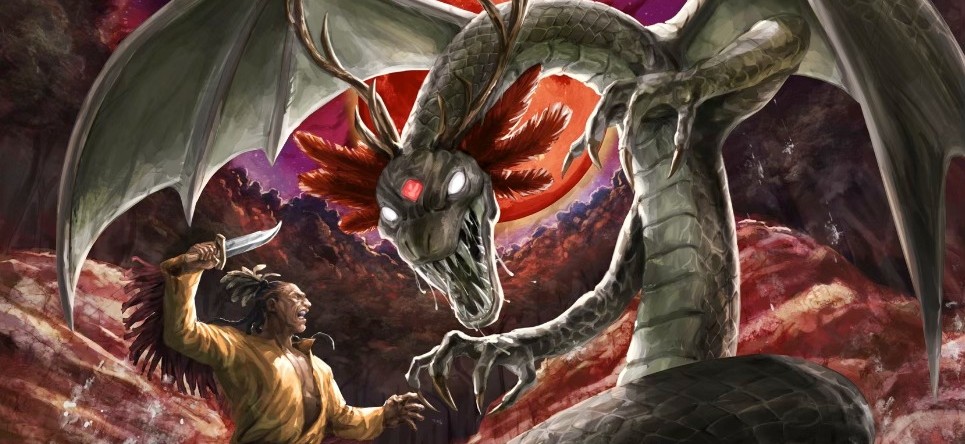Since the Meiji Restoration, the works of English playwright William Shakespeare have been read and renowned in Japan. One of those admirers included legendary filmmaker Akira Kurosawa. Since the early days of his career, Kurosawa had taken a liking to many of Shakespeare’s most notable works, including Hamlet. Yet, his favorite was Macbeth, a dark cautionary tale of how unchecked ambition and greed for power can bring about one’s downfall. Many of the timeless themes within this story resonated with Kurosawa, as they reign true to then-current day issues within society. He liked this play so much that he aspired to make a film adaptation one day. 1957, this wish became a reality when he released his masterful jidaigeki film Throne of Blood.
For newcomers, jidaigeki, which translates to “period drama,” is a genre of historical entertainment typically set before the Meiji Restoration, a political revolution that began in 1868 and ended in 1889. A few creative liberties were taken for this adaptation of the classic English play. The setting and culture of medieval Scotland would be translated into feudal Japan, the age of the samurai. Beyond his admiration, Akira Kurosawa assembled regular screenwriters Shinobu Hashimoto, Ryuzo Kikushima, and Hideo Oguni to ensure this type of story and the themes of Macbeth were done justice. Additionally, much of the film’s theatrical stylistic choices are derived directly from the traditional Japanese drama art form Noh, which Kurosawa was fond of. With this being a Toho production riding off the successful height of the 1950s, the golden age of Japanese cinema, the film would have a sizable budget. The money would be put to good use, not just for costumes and in-studio shooting, but set pieces built and shot on Mount Fuji’s foggy, high-altitude slopes and within the beautiful, luscious setting of the Izu Peninsula.

Furthermore, this would be Akira Kurosawa’s first venture into the world of tokusatsu. The director admired the art form, even citing the original Godzilla by his longtime friend Ishiro Honda as one of his favorite films. Fittingly, the special effects for Throne of Blood would be directed by SFX master Eiji Tsuburaya. Decades later, Kurosawa would direct another special-effects-heavy film, his magical realist anthology Dreams.
Our story begins with General Taketoki Washizu (Macbeth) and General Yoshiaki Miki (Banquo), two samurai commanders who serve Lord Kuniharu Tsuzuki (King Duncan), who resides in the castle of the Spider’s Web Forest. Following a battle against the lord’s enemies, Washizu and Miki head back to their leader’s fortress. However, while treading through the forest, they encounter an evil spirit (The Three Witches). The ghostly woman speaks a prophecy to the men that henceforth, Washizu will be named Lord of the Northern Garrison while Miki assumes commandment of the first fortress. Additionally, one day, Washizu will become the Lord of Spider’s Web Castle, and Miki’s son will eventually take the throne. Before this can be entirely comprehended, the ghost vanishes. To both warriors’ surprise, they are rewarded just as the entity had prophesized. Washizu confides in his wife, Asaji (Lady Macbeth), about the spirit’s prophecy. Inspired and driven by a lust for power, Asaji manipulates her husband into murdering Lord Tsuzuki and framing his guards as the culprits, with the Washizus now claiming the throne for themselves. Now assuming the power of the Spider’s Web Castle, Lady Asaji continues to influence her husband’s next moves when she becomes pregnant, even encouraging him to turn against his friend, Miki. As Lord Washizu’s ambitions intensify, he descends into madness as the once noble warrior transforms into an evil warlord.
Despite the transposition from medieval Scotland to feudal Japan, Throne of Blood stays true to the structure, tone, and themes of William Shakespeare’s Macbeth. There are only a couple of changes that perhaps will stand out to Shakespeare enthusiasts. The film is on a slightly smaller scale, with most battle sequences occurring offscreen and most onscreen violence being Washizu inflicting cruelty among his men. This move was a creative choice Kurosawa intentionally made as he wanted to emphasize the psychological drama of the characters further and make the movie’s shockingly violent finale even more impactful when it happens. The three witches who prophesize are also substituted here for one evil spirit. Even with the differences in language and culture, Akira Kurosawa does an excellent job giving his unique spin on Macbeth. Yet besides being a commendable translated adaptation, Throne of Blood is a gripping samurai drama that is thematically immersive and equally haunting.
For one, the feudal setting in the movie is nightmarishly unsettling, a period of civil war and crumbling order with claustrophobic forests and foggy terrains. Along with near-seamless transitioning from on-location shooting to detailed sets, the world here feels haunted and consumed by evil, where good people are victimized while the wicked reign their misdeeds. It is as if our characters are trapped within some hellish landscape with no escape, and the only logical thing to do is go mad. Even the Spider’s Web Castle feels haunted with its large rooms that function like liminal spaces and moody lighting where the inhabitants are either significantly highlighted or submerged in darkness.
Although the lack of samurai action may put some viewers off, Throne of Blood makes up for it with its engrossing themes and compelling character drama. We primarily see this in how Akira Kurosawa critiques human existence and its continuous injustices and hypocrisy, which are especially prevalent with Washizu’s rise and fall. The samurai often prided themselves on their devotion to the Bushido code and its concepts, such as loyalty, honesty, and honor. Yet, this is rendered moot and completely meaningless when accomplishments are achieved through greed, dishonesty, and murder, all of which can drive an egomaniac to extreme levels. Like the source material, the movie’s driving theme is a cautionary tale of ambition. The eccentric desire for power can corrupt one’s touch on reality and strip away any humanity left in them. As one’s actions become crueler, one can fall into insanity, where madness is inescapable. By the end, Washizu and Asaji pay for their crimes against humanity as the spirit’s prophecy ends with tragedy and revenge. Additionally, the idea of fate is key to this story and what we ultimately make of it through our actions. It is as if Kurosawa is warning humanity not to frequent a systematic cycle of mistakes, for the recurrence of those errors results in history being doomed to repeat itself.
Violence is relevant to the movie’s thematic crux as the Spider’s Web Castle becomes a bloodbath. While much of the gore is quite tame by today’s standards, there remains an unsettling, realistic brutality to it all. Feudal Japan was frequently a historical time of civil war, where order gradually crumbled, and death was common. The bloodstained room with arrows where the two leads hatch their diabolical plan represents their destiny. Even though Lord Tsuzuki’s murder occurs offscreen, the image of a visibly shaken Washizu holding a bloody spear conveys what the movie is all about. With each slaying he commits henceforth, he becomes more desensitized. A scene in which Asaji tries to wash blood off her hands becomes disturbingly significant later in the film when the act is initially coldly calculated but later becomes a sign of trauma following a tragic event. Then, of course, there’s the spectacular finale when Lord Washizu’s façade comes crashing down. He pays the ultimate price when his own men turn on him and fire arrows at him, putting his reign of terror to an end.
How Akira Kurosawa incorporates elements of Noh theater into Throne of Blood adds a unique appeal to the film. Notable characteristics include frequent intentionally choreographed movements to indicate meaning, make-up/exaggerated facial expressions reminiscent of Noh masks, and the traditional Japanese music score. A lot of the imagery is also quite like Japanese paintings. Often, translating theater to film is not an easy feat. Yet, Kurosawa integrates it seamlessly into the feature to create a feeling of unease and invoke intensity, making the experience even creepier and more unsettling.
Being a late 1950s Toho production helmed by Akira Kurosawa, Throne of Blood features a stacked cast. Yet, it’s primarily the two leads who elevate the film to another level while effectively incorporating elements of Noh theater into their expressive, intense acting. Toshiro Mifune is terrific as Tatetoki Washizu, this film’s Macbeth, with a disturbingly gripping performance as an ambitious, loyal warrior who transforms into a power-hungry, murderous warlord. Mifune’s descent into madness becomes more unsettling to watch the more Washizu falls deeper down the rabbit hole. Isuzu Yamada is phenomenal in her chilling performance as Washizu’s ruthless wife, Lady Asaji Washizu, the Lady Macbeth of this feature. In contrast to her costar’s bombastic, animalistic tendencies, Yamada’s cold stare and ominous commanding presence make her a truly frightening character, and she similarly nails her eventual fall into insanity.
The supporting cast includes many recognizable faces, including Takashi Shimura and Akira Kubo. However, the primary standouts are Minoru Chiaki and Chieko Naniwa. Chiaki brings a likability to Yoshiaki Miki, which makes when he eventually falls victim to Washizu and Asaji’s cruelty even more tragic. If Lady Asaji wasn’t terrifying enough for the audience, Naniwa is ungodly creepy as the evil spirit who prophesies what transpires throughout the film. Despite only having two scenes in the movie, you’ll never forget her. The first scene alone, when we are introduced to the ghostly woman eerily singing and weaving in a hut within a foggy forest surrounded by bones, will surely give viewers the creeps.
Aesthetically, Throne of Blood is a visual tour de force. From a production standpoint, Akira Kurosawa and the team deliver gorgeous set pieces and costumes that ooze with tons of historical attention to detail to capture the essence of feudal Japan. As previously highlighted, the mixing between on-location shooting on the naturally foggy Mount Fuji and the spectacular Izu Peninsula to in-house sets is smoothly executed. All of this is captured tremendously by frequent Kurosawa cinematographer Asakazu Nakai. Furthermore, Kurosawa’s editing is consistently outstanding throughout. Eiji Tsuburaya’s special effects work here is also impressive, especially for the sequences involving the evil spirit. Lastly, Masaru Sato’s music score enhances the film’s atmosphere with chilling orchestrations and the prominent use of the flute, drums, and chanting. Yet, the movie also makes effective use of silence in many moments as well.
Of course, it would be a disservice not to discuss the film’s most iconic moment, the climatic arrow sequence, when Lord Washizu meets a violent end at the hands of his men, who accuse him of murdering the previous lord. It is a spectacular scene that, even today, is incredibly intense to watch. The behind-the-scenes details of how this sequence was staged make this scene even more mind-blowing. Kurosawa hired proficient archers to fire real arrows at Toshiro Mifune to invoke authenticity. Yes, most of those arrows were, in fact, real. Hence, even though he is wearing protective armor underneath his costume, the look of fear on Mifune’s face throughout this scene is genuine. One can only imagine the relief he felt once filming was completed.
Atmospheric and thought-provoking, Throne of Blood is fantastic. Everything from the writing, performances, and production values land here. Not only does Akira Kurosawa deliver an impressive adaptation of William Shakespeare’s Macbeth, but he also presents a gothic samurai feature that captivates with a haunting cautionary tale of misguided ambition and the consequences it brings upon those desperately eager for power while effectively incorporating its historical/cultural backdrop.





